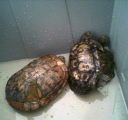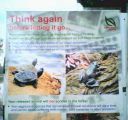 wildsingapore
home
wildsingapore
home
moblog singapore home
ria's blog on moblog
about wild lives
our wild cause
 wildsingapore
home wildsingapore
home
moblog singapore home ria's blog on moblog about wild lives our wild cause |
| wild
thoughts:
Should we release animals into our wild places? Here are some important thoughts arising from my mms upload on Abigayle's Turtle Study. Do share your thoughts on this issue :-)  Posted
by yman Posted on 27/07/04 22:24 Posted
by yman Posted on 27/07/04 22:24I think the man still don't get it. Why do some ladies tell others not to release animals into our nature habitats when they do so in the name of "a study"? Unless I got the facts wrong here, were the turtles indigenous to Macritchie reservoir? Or were they introduced from somewhere else? A few months back, on a Vesak holiday, a group of people from the Nature Society stationed themselves around various popular nature spots where animals were often released into the wild. They tried to persuade the devotees from releasing the animals, which was supposedly an act of compassion for the devotees. The message the Nature Society people tried to convey was the dire consequences that these non-indigenous animals will suffer in the wild. So it was a good cause indeed, and true empathy and compassion it was for the animals. But the so called "turtle study" will certainly irk some people, like me for instance. Isn't it ethically wrong to subject the turtles to undue stress, and even death (as it was suggested). I am sure the researchers would have read Research Ethics 101, and hopefully will give the turtles or other animals the benefit of ethical doubts in future "studies". I hope I am not starting a gender issue here :). I hope only to reflect on the issue of research ethics. Perhaps people reading this may want to add their comments too. ( :> Yman)  Posted
by Ria Posted on 28/07/04 09:06 Posted
by Ria Posted on 28/07/04 09:06 Dear Yman, Abigayle is studying non-native (i.e., introduced turtles) that are already found in our reservoir. In Abigayle's study, she has a look at these turtles and releases them after she measures and marks them. They are NOT killed as you suggested. They are treated gently and they are not unduly stressed. These non-native turtles are brought into Singapore for the pet trade, and most get into our waterways as people release them when find they don't want to keep them as pets any more. Her study of these turtles released by the public will help us better understand the impact of the release of non-native turtles into our waterways. My personal belief (and I am partial to the Buddhist view of life), is that to be truly compassionate, we should work towards ending wild life trade and irresponsible pet keeping. This is best done through a better understanding of the situation (such as through Abigayle's study) and through gentle raising of awareness(as was done by NSS on Vesak Day). Releasing of wild animals into places where they don't belong (a) stresses the released animals (b) stresses native animals that are already there (c) supports the wildlife trade. Certainly I would love to hear comments and discussion on this issue. I don't think NSS or devotees are on opposite sides of the issue. I believe both have the best interests of the animal at heart :-) Posted by gobygirl on 28/07/04 Hi Yman, I think your misinformed comment came about because the objectives of the study and subject of study was not made clear enough. Animals and plants which are non-native are causing havoc in many ecosystems to which they are introduced. This is a serious problem, so much so that in some countries, introduced animals are actually gathered and culled in a massive fashion so that native animals are saved. This is especially prevalent in Australia where marsupials tend to be less agressive than their placental (and introduced to Australia) counterparts. I am not advocating this practice in managing wildlife but just trying to illustrate scenarios in other nations. This problem of alien introduction is so massive that a whole scientific journal called "Journal of Invasive Species" has been borne just for this particular subject. The situation in Singapore is especially bad because we are in the centre of a very thriving pet trade. We often, in our studies of nature areas in Singapore, come across many species that have escaped or have been deliberately released. These include many species of birds, amphibians, reptiles, fishes and even mammals. In fact, there is a group of Sulphur -Crested Cuckatoos, originating from Australia, that are thriving very well on Kent Ridge. Also, the most abundant fish in our fresh and brackish water areas are tilapias, a native of Africa. Now, they are slowly being driven out by yet another non-native fish, the Green Chromide, originating from India. All these have a grave impact on our own fauna and even flora. We see a significant reduction in native fishes and a population explosion of introduced animals that have managed to out-compete our native ones and upset the existing ecosystem balance. However, it is difficult to make claims without scientific data as backing because policy-makers need hard evidence before legislations can be made. Ms Abigayle Ng is currently working on her Masters Thesis on the Red-eared Slider, an American terrapin brought into Singapore via the pet-trade in the recent past. Soon after, we began finding them in our waterways due to accidental/deliberate releases. Terrapins native to Singapore are the Black-Marsh Terrapin, the Malayan Box Terrapin, soft-shelled terrapins and several other species of terrapins. However, it is extremely rare to see them nowadays. Studies such as Abigayle's are actually very very very important in helping us answer questions like a) what species of terrapins are present in our waterways b) the population distribution, size and density of both native and introduced terrapins c) assess the current situation d) the extent of effect introduced terrapins have on our local ones e) if introduced terrapins are competing for resources such as food, shelter or nesting space with local ones f) if they are breeding and thereby causing more competition g) if there is any way we can curb future releases and manage the current non-native populations in our waterways. What Abigayle does, (with permits from NParks and PUB) is set traps for terrapins. She takes special care to check her traps evey 30 minutes so that the terrapins are not stressed when in the net. The terrapins are, WITHOUT taking them back into the laboratory, measured and weighed in the area. Please note that she is certainly not obliged to do this but this would ensure minimal stress on the animals. The terrapins are then marked on the outer parts of the shell, which is similar to filing your fingernails and thus not harming the animals. Again, there are many methods which are easier to carry out in marking terrapins but Abigayle chose this to ensure that these creatures are not hurt. This has to be done so that she can identify recaptured animals and note the growth/changes. After this brief contact, the terrapins are released back into the waterway. Hence, in my humble opinion, this is a VERY ethical study which respects all animals involved. I hope you now understand the scope and importance of this research work. Data such as this is invaluable to us and would help us champion the conservation of our native biodiversity. Regards, GobyGirl Posted by yman Posted on 28/07/04 22:29 It's a great relief to hear that no harm was ever intended for the turtles. People can thus be reassured that whatever studies by our nature scientists are performed with good intentions. In this case, I think the NSS is doing a great job, both in educating the masses and in fighting the fire on the ground. Abigayle and company should also be given a pat on their backs for their efforts too. It is not everyday that such care and concern are lavished on animals at risk. I have a friend who is trying to educate pet owners to avoid discarding their pets. It is a common problem every year, during the spring cleaning season prior to the lunar new year. Besides clearing their junk, home owners also discarded their pets into the streets. So it has become an annual sight to see pedigree dogs and cats wandering around HDB blocks during the spring cleaning season. I have personally come across a group of teenagers who bought a pair of baby bunnies from a pet shop at the spur of the moment. I happened to be at the pet shop and could not help noticing the excitement of the group over the pair of bunnies. Strangely, they did not buy a cage, but asked for a card box to bring the rabbits home. A hour or so later, as I was walking pass a park bench nearby the pet shop, I noticed a similar box beside it. And nearby were the pair of rabbits, minus the teenagers. Probably abandoned after the thrill was over. An elderly couple then took the bunnies away. One wanders why such things happen. Its' a fact of life, and it won't be something to be eradicated overnight. With people like NSS, Abigayle and company, we see compassion in its true sense. (:> Yman) |
these blog entries were first uploaded on MoBlog Singapore! Celebrate Singapore NDP 04 website©ria tan 2004 |